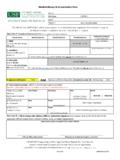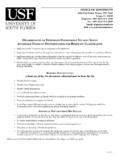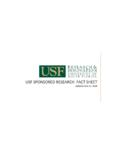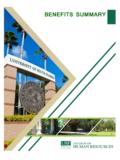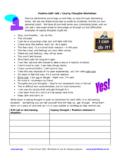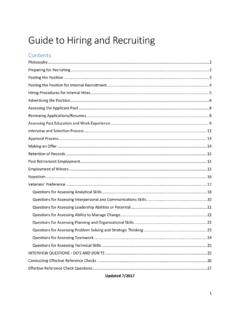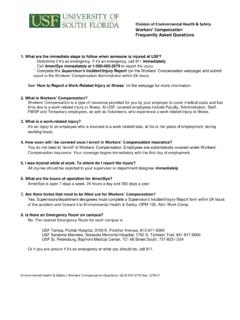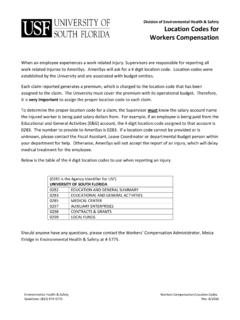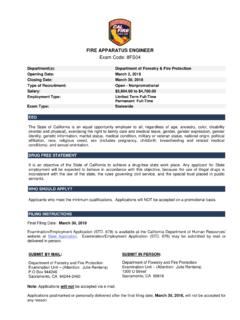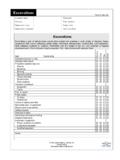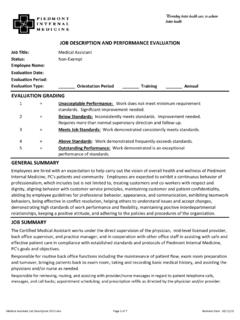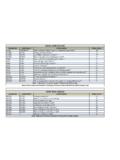Transcription of STANDARD OPERATING PROCEDURES - usf.edu
1 STANDARD OPERATING PROCEDURES DIVISION OF COMPARATIVE MEDICINE UNIVERSITY OF SOUTH FLORIDA SOP#: Date Issued: 11/00 Date Revised: 3/17 Page 1 of 7 _____ TITLE: Employee orientation and Training SCOPE: All New Animal Program Personnel RESPONSIBILITY: Assistant Director, Facility Manager, Training Coordinator, All Animal Program Personnel PURPOSE: To Outline the Proper PROCEDURES for the Introduction of Institutional and Divisional Policies and PROCEDURES , Provide Documentation of Health and Risk Assessment, and Certify Adequacy of Training and Experience of All Employees _____ I. orientation and TRAINING with the ASSISTANT DIRECTOR 1. Human Resources, Payroll, and Divisional Policies a. Each new employee of the Division of Comparative Medicine meets with the Administrative Assistant Director (AD) to ensure all Human Resource requirements of new employees have been met.
2 An orientation of Animal Care Staff document (CMDC #102) is initiated. Once completed, this document is returned to the AD to file in the employee s training file. b. The new employee is provided an overview of the University s Global Employment System (GEMS). In addition, information is provided regarding the payroll system and how to track and submit timesheets for payment. c. The AD establishes new employee and personnel files to track training, education, and dates of occupational health and risk assessments. d. Three files are established and maintained in the Administrative Office for each new employee: 1. Personnel file (which includes verification of education and certification) 2. Training file 3. Occupational Health file (which includes information regarding Workers Compensation claims) 4. Files are maintained for length of employment. Once employment is terminated, all files are archived and maintained for a period of 5 years.
3 E. The Assistant Director introduces new employees to the divisional Employee Policies (CMDC #098) and provides them with their own copy. Divisional policy compliance is expected of all employees, and proper PROCEDURES are explained for: 1. Work schedules 2. Calling in sick 3. Requesting time off 4. Conduct 5. Completing timesheets f. Each employee is provided a copy of Employee orientation and Training (SOP #013). SOP # Employee orientation and Training Effective 3/17 Page 2 of 7 2. Occupational Health and Safety a. Each new employee of the Division of Comparative Medicine, jointly with the AD, is required to complete the Health and Risk Assessment for Employee Safety In The Care and Use of Animals (RIC #004). The AD reviews health and safety principles and relevant STANDARD OPERATING PROCEDURES with all new employees so that they are informed of potential hazards associated with their work, understand how these hazards are controlled, and have knowledge of safe work practices and the use of protective supplies and equipment.
4 Once completed, the Health and Risk Assessment document is maintained in the employee s Occupational Health file. b. Employees are scheduled for comprehensive health services provided by USF Medical Health Administration, which consist of serologic documentation of immunization with rubella, rubeola, varicella, hepatitis B, Hepatitis A, and diphtheria/tetanus. Documentation of rabies vaccination and TST/PPD skin test or BCG vaccination for tuberculosis may also be requested depending on the animal models in use. USF Medical Health Administration maintains records of the results of these health assessments and vaccinations and provides Research Integrity & Compliance with written confirmation that health services have been completed, documentation of which is uploaded to the employee s profile in the ARC system for IACUC certification. c. Employees are informed that an Occupational Health Care Physician is available to discuss any preexisting, existing, or possible future health conditions that could affect their ability to perform their duties.
5 D. The AD presents information to new employees regarding the USF Hearing Conservation Program viewable at: and the Division s Respiratory Protection Program. Records relating to the Hearing Conservation Program are maintained within the offices where the audiograms are conducted at the Department of Communication Sciences and Disorders. Records relating to the Respiratory Protection Program are maintained within the employee s Occupational Health file in the Administrative Office. e. The AD presents information to new employees on potential work-related injuries and reviews: 1. Proper PROCEDURES for reporting suspected health hazards and work-related injuries. Bites, scratches, or any accident should be reported to a supervisor immediately and an incident report filed for each occurrence. 2. Information regarding potential zoonoses, practices of personal hygiene which limit exposure, and risk of contracting zoonoses.
6 This information and the nature of noxious, toxic, hazardous, infectious or carcinogenic agents or compounds, when used, are posted on the door of the room containing the animal collection exposed to such agents. 3. SOP # 906 entitled Chemical Hazard Communication, SOP #901 entitled Material Safety Data Sheet (MSDS), and the USF Chemical Hygiene Plan viewable at: to acquaint new employees with chemical hazards in the work place and practices of safe chemical use. 3. Training & Regulations SOP # Employee orientation and Training Effective 3/17 Page 3 of 7 a. New employees are introduced to the New Employee Training Checklist (CMDC #038). Each facility has a specific checklist that is designed for training new employees on the species, PROCEDURES , and equipment that may be encountered at that particular facility. New employees are expected to complete the material in the checklist in the time frame allotted on the checklist.
7 B. The AD reviews the Disaster Response Policy (CMDC #34) and the Emergency Contacts Sequence (CMDC #153). c. New employees are informed of safety training requirements: 1. Biosafety training 2. Lab Safety/Hazardous Waste Training d. The AD provides new employees with an introduction to the Guide for the Care and Use of Laboratory Animals ( the Guide ), the Animal Welfare Regulations (AWR), the Public Health Service Policy ( PHS Policy ), and IACUC Principles & PROCEDURES of Animal Care and Use and provides them access to copies to read and become familiar with so that care, treatment, and use of animals will be in accordance with these policies. II. orientation and TRAINING with the FACILITY MANAGER 1. New employees continue completing the New Employee Training Checklist (CMDC #038) with the facility manager/supervisor of the facility to which they are assigned.
8 This affords the employee training in the species, PROCEDURES , and equipment that may be encountered at that particular facility. The checklist is in a format that lists the training subjects and the specific materials containing information related to the activities at the assigned facility. This checklist is intended to serve the employee as a comprehensive reference of the information they are expected to know and serve the managers as a checklist to document that new employees have been thoroughly trained and are familiar with the practices, policies, and PROCEDURES of the laboratory animal facility. 2. Employees are expected to complete the material in the checklist in the time frame allotted on the checklist. The completed New Employee Training Checklist is submitted to the AD to be included in the employee s training file. 3. During the first two weeks of employment, new employees are provided on-the-job training by being assigned to work with trained personnel as they perform their daily duties.
9 This affords new employees with the opportunity to observe, receive instruction, and ask questions while carrying out these duties under direct supervision. New employees are assigned to as many established employees as necessary to provide rotation through all animal rooms and exposure to all the STANDARD policies, practices, and PROCEDURES 4. Facility managers and supervisors make certain new employees are afforded time to read the related SOPs/materials associated with each species or procedure as they are being trained to insure proper and thorough training. 5. As the employee completes their on-the-job training and the required reading, the facility manager will discuss the particular topics on the checklist with the employee to determine whether they can demonstrate sufficient knowledge of divisional policies, practices, and PROCEDURES .
10 When satisfied that the employee has demonstrated a SOP # Employee orientation and Training Effective 3/17 Page 4 of 7 thorough understanding of the subject matter, the manager/supervisor, or their designee, will initial and date next to the topic on the checklist to document that training has taken place. This is repeated for each topic on the checklist. 6. As part of the orientation of Animal Care Staff , an Employment Site orientation is conducted with the facility manager to provide information to new employees about specific site-of-employment policies and PROCEDURES and includes discussions regarding: a. The procurement of university and facility identification cards b. Access cards c. Keys (if applicable) d. Parking & parking permits e. Scrubs f. Shoes g. Locker space 7. New employees are provided with a facility-specific list of phone numbers and contact information.
